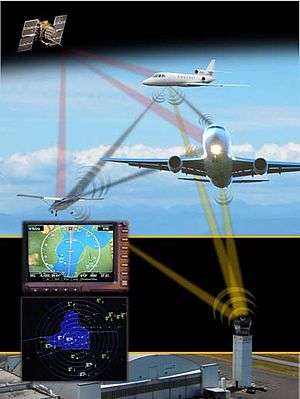Radionavigation-satellite service
A radionavigation-satellite service (RNSS) is "a radiodetermination-satellite service used for the purpose of radionavigation. This service may also include feeder links necessary for its operation".[1]

RNSS is regarded as a safety-of-life service and an essential part of navigation which must be protected from interferences.
Classification
ITU Radio Regulations (article 1) classifies radiocommunication services as:
- Radiodetermination service (article 1.40)
- Radiodetermination-satellite service (article 1.41)
- Radionavigation service (article 1.42)
- Radionavigation-satellite service (article 1.43)
- Maritime radionavigation service (article 1.44)
- Maritime radionavigation-satellite service (article 1.45)
- Aeronautical radionavigation service (article 1.46)
- Aeronautical radionavigation-satellite service (article 1.47)
- Examples of RNSS use
- Augmentation system GNSS augmentation
- Automatic dependent surveillance – broadcast
- BeiDou Navigation Satellite System (BDS)
- GALILEO, European GNSS
- Global Positioning System (GPS), with Differential GPS (DGPS)
- GLONASS
- NAVIC
- Quasi-Zenith Satellite System (QZSS)
Frequency allocation
The allocation of radio frequencies is provided according to Article 5 of the ITU Radio Regulations (edition 2012).[2]
To improve harmonisation in spectrum utilisation, most service allocations are incorporated in national Tables of Frequency Allocations and Utilisations within the responsibility of the appropriate national administration. Allocations are:
- primary: indicated by writing in capital letters
- secondary: indicated by small letters
- exclusive or shared utilization: within the responsibility of administrations.
| Allocation to services | ||
| Region 1 | Region 2 | Region 3 |
5 000–5 010 MHz
| ||
See also
- Radio station
- Satellite navigation
- Radiocommunication service
References
- ITU Radio Regulations, Section IV. Radio Stations and Systems – Article 1.43, definition: radionavigation-satellite service
- ITU Radio Regulations, CHAPTER II – Frequencies, ARTICLE 5 Frequency allocations, Section IV – Table of Frequency Allocations